Tearing during birth can happen at delivery. Why does it happen, how can you prevent it and recover?
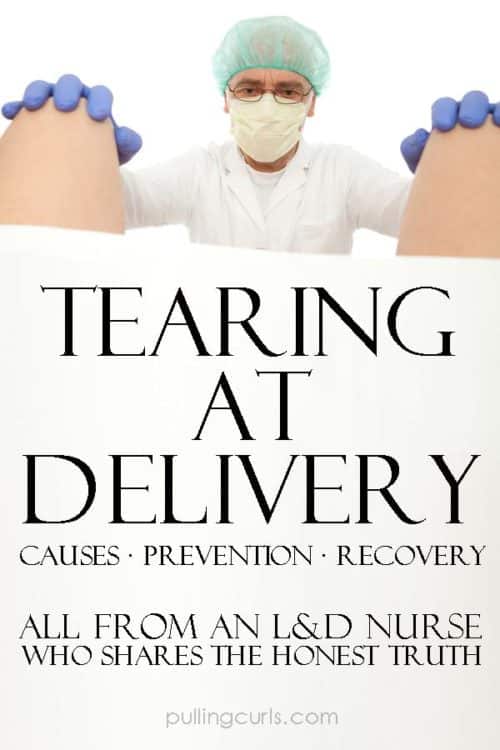
I’ve been seeing a lot of posts on Pinterest lately on preventing tearing during birth. I always click greedily into the post to see what tips they have (this is what labor nurses do for fun).
And then I leave dejected.
The thing is, everyone is kind of a fan of their perineum (in case you didn’t know, your perineum is the skin between your vagina and your anus).
I mean, without it — you mostly just envision all your guts falling out.
I bet tearing might be one of your biggest fears about delivery — and that’s a normal one.
So, let’s talk about tearing, why it happens, what causes it, some possible ways to prevent it and what to do afterward.
**You might wonder why the heck I know so much about tearing, and that is because I've been an L&D nurse since 2001. You can even sign up for my pregnancy series to get helpful information all through your pregnancy, just for the stage you're at!**
If you’re in the zone of wanting to learn more abouy your delivery, I totally recommend this.
Causes: Why Tearing Happens
Tearing happens when the head comes out of your vagina. As you can imagine – your Vagina (hopefully) is not the size of a baby’s head, normally. However, it is meant to stretch and adjust as the baby’s head comes down.
Depending on a number of factors, the vagina and/or your perineum can sometimes tear.
We grade the tear in degrees. First degree is pretty small, and 4th degree extends into the anal sphincter tissue. You can also extend to the Anus, which happen to very special people like me. **Spoiler alert – I’m still alive **
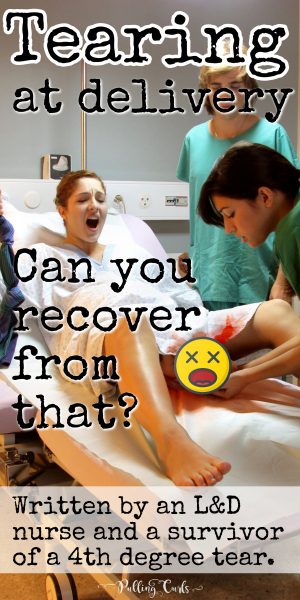
Information about episiotomies
An episiotomy is when your practitioner cuts your perineum. It can happen for a variety of reasons
- Your doctor always does it.
It’s pretty rare anymore, but I know doctors who always do it. You can ask your doctor their episiotomy rate. They should know. We do give the data to the doctors (computers are handy this way). It should be low. I don’t see them frequently.
Some doctors believe you heal better with an episiotomy than a jagged tear. I’m not sure I agree with this. 😉
- Baby is not safe inside anymore
If your baby’s heart rate is dipping and delivery needs to be soon, your doctor might cut an episiotomy to get it out faster. It can speed up delivery.
- Your doctor is “so busy”
Yup, they might not want to wait anymore for delivery. So, they cut.
Again, I see that super rarely anymore.
You always have the option to say “nope” to an episiotomy. The doctor should ask you if it’s OK (unless it is truly an emergency) and you can always say – no, I’d like to try on my own, thank you very much. You can learn more about informed consent here.
**I have been getting a LOT of emails lately with women who aren’t sure how to talk to their doctor — that post about informed consent is SUPER helpful to talk their talk and try to understand each other better, I totally recommend it (and I also have webinar in getting the labor you want)**
[thrive_leads id=’31330′]
Related post: If you have an epidural does childbirth still hurt?
What causes tearing at delivery?
Tearing happens for a few reasons:
**First off – none of these things are the “kiss of death” – just because one happens doesn’t mean you’re sure to have a tear**
- Baby’s head size.
When I married my husband I did some thorough discussion with his mom about the size of his newborn head and shoulders. He seemed like your basic run of the mill baby – so I married him. This is a true story.
- Baby’s head positioning
Babies are meant to come out looking down at your bum. If they come out looking up (also called OP or “sunny-side up”) the head doesn’t have the same ability to flex and adjust to the vagina and the opening. It can cause tearing.
- Your tissue type
I don’t see this often in women of good nutrition, but often when I had poorly nourished patients the tissue would just sort of fall apart. Their diet consisted of a lot of rice, and soups. Very little meat. They just weren’t fully nourished.
It also made for a hard time to sew them up. Kind of think of fraying fabric.
Anyway, have a burger. 🙂 The nutrition you’ve had all your life helps make up your tissues — but it is important to stay well nourished during your pregnancy (which, frankly — most women don’t have a problem doing).
- Speed of delivery
If you blow your baby out at home, you’re likely going to tear. In fact, some of the worst tears I’ve ever seen have been at un-anticipated home births.
This is a nice stretching that happens as you give a controlled push. It doesn’t feel great, but it can prevent you from tearing.
- Skill of your practitioner
I’ve delivered a few babies in my time. But, there are things we do as the baby comes out to support the tissues and allow the delivery at a good pace, but not too fast. Slow it down too much, and you’ll tear at other spots, slow it too little and you don’t get the stretching I mentioned above.
Which is why you really want to be picky when finding a doctor.

Prevention of tearing at delivery
Ahh, the stuff dreams are made of….
Preventing tearing.
Well, if you read the above section you’ll see that there isn’t a whole lot you can do about a few of them. But, there are some things you can do.
- Marry someone with a small head. 🙂 Or, if you’re not the marrying kind — only have sex with people who have small heads, or examine their baby picture to see if they came out with a giant noggin. 🙂
- Eat a well-rounded diet that allows your body to create tissues that are healthy and strong. The Bradley Method recommends having an egg every day during your pregnancy and I am actually a fan of this advice. Either way, eat a balanced, nutritious diet.
- Listen to your doctor: When he says to not push too hard, listen to him. You might feel greedy that you want the whole experience over, but those extra 30 seconds could really help your perineum. It will thank you for it. 🙂
- Pick a doctor you trust. Ask them their episiotomy rates, and mention that unless there is an emergency you’d prefer not to have one. Mention you’d also like to be asked before he cuts one. Also, trust him/her. Make sure they aren’t the lazy ones mentioned above. 🙂
I do not recommend vaginal stretching. I’ve seen articles that say it does more harm than good.
I always recommend Kegal exercises. They might help you recover faster, but they won’t prevent you from tearing.
I do believe there could be something too hot/cold compresses, but that would be something to ask your nurse about. It would certainly depend on if your tissues are swelling or if they’re noticing anything else.
There may be something to essential oils — but each person’s body reacts so differently, I certainly wouldn’t recommend them across the board.
EXCLUSIVE CODE: Use coupon code PULLINGCURLS to get $20 off The Bosch Mixer (also in stainless steel), Classic Grain Mill & Harvest Grain Mill, at Nutrimill.com
My Favorites:
🤑 The Artiste is a gem of a mixer at a great price.
💚 The Baker’s pack is what I use at my house, the paddles and the scraper make this my favorite mixer!
(💲💲💲 Use code PULLINGCURLS on either of those too to save $20)
What to do afterward ~ Recovery from tearing at childbirth
Don’t miss my BEST tips for AFTER baby!
My best advice is that tearing is something you can come back from! People LOVE this stuff.
You will still be able to use your vagina for a playground (waiting at least the 6 weeks of pelvic rest).
Life will go on… by doing a few things.
My post on postpartum comforts outlines some of my very best advice — since this post is already twelve miles long, I’ll just let you click on over to that.
I bet you CAME to this post because you’re nervous about tearing, and likely other things — like the epidural the IV. This Online Prenatal Class covers everything from 3rd-trimester testing, up through your first months home with the baby.
It’s going to put fears like this one to rest. I even have a beginning version, if you’re wondering if it’s for you.

And be sure to check out my other postpartum tips right here:
[pt_view id=”2536809779″]
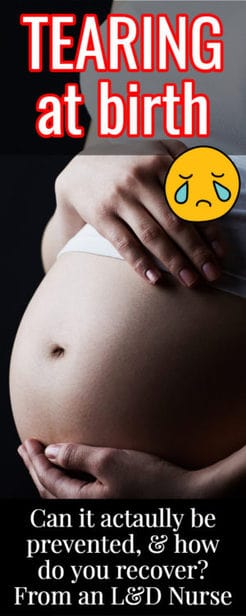


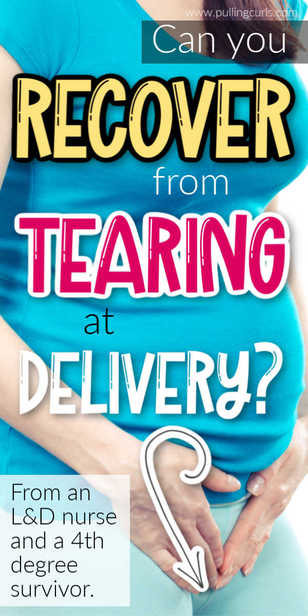



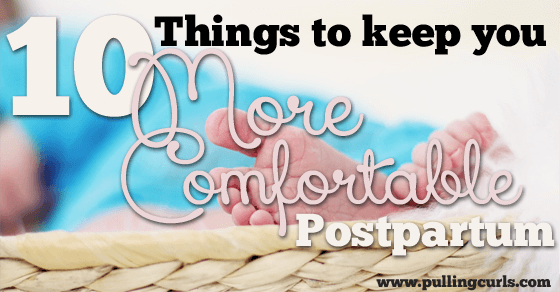





Emily says
Really great information here on the different kinds of tearing and how they can happen. Though someone’s diet can’t be assumed based on their race. I’m all for healthy nutrition and having a variety of food to support tissues, but I wouldn’t say that a western “white” diet is necessarily better or worse then any other cultures. Also, Asian is a pretty wide generalization.
Hilary Erickson says
Godo point, I changed the post up. 🙂
Briony Rea says
Really unhelpful article. If the aim was to scare women with your own horror story and lightly sugar coat “not much you can do” with a sprinkling of advice that only reiterates the above “nothing much you can do” opinion then mission accomplished. Light massage of the perenium with mineral oil in the weeks prior to birth coupled with warm compress pads did wonders for me, first son level one only, second nothing. And both my sons had quite large heads and weighed over 8/9 pound respectively.
Hilary Erickson says
The reality is that a lot of the articles that CLAIM to be helpful truly aren’t. But, that’s just my personal opinion after seeing over a thousand pregnant women….
Mary says
Rather difficult to read the article with all the ads. I had to go back and forth a bit as I skipped some of it due to all the ads
Hilary Erickson says
I’m sorry you feel that way, I will look at it — but advertising does provide an imoprtant part of funding to provide you free content.
Julie Fuller says
Dermoplast is horrid!! It has parabens and butane (lighter fluid) in it. Not good for the bottom!! I make an organic herbal soak called Undercarriage Repair that will heal to heal those beat up bottoms!! Check it out on etsy if interested!!
Hilary Erickson says
Yeah, I don’t think it has all the best stuff, but it sure does feel good!
Hayley says
Pushing while I could feel myself tearing was probably the hardest bit about my whole labor and birth. I ended up with 2nd degree tears – my baby’s head was in the 99th percentile (It’s not even my hubby’s fault, I’m the one with the big head!) – so could have been worse!
While it’s not fun it is over with quickly and your body is designed to heal very well down there.
In my opinion it’s not worth spending a whole lot of time worrying about it.
Hilary Erickson says
I agree — you can certainly move on. 🙂
Gia says
Kegals only work if you have something inside of you to contract against. Otherwise, you create dysfunction in the pelvic floor. If you look back at the history of kegals, that’s how they were meant to be done, but then we went away from the internal pressure monitoring and they became less effective. Make an appointment with a pelvic floor PT if you feel you need direction.
Hilary Erickson says
I actually did see a pelvic floor PT for a few months in 2009… it wasn’t my favorite. 😉 But I agree — I have a post that talks about something like that: https://www.pullingcurls.com/urinary-incontinence/
Kaitlin says
I’ve read that women who have a natural birth are more likely to tear.. is that a bad fact? Haha .. I’ve had two baby’s both under 7 pounds amd smaller heads and I had a epidural with both .. i had horrible pain in my back around where the epidural would have went after I had my last daughter for almost a year and also my tailbone hurt pretty bad too because I had to wait to push because my doctor was on her way and the students and nurses saw her head.. so I tore pretty bad with her.. wanting to get pregnant again but I’m trying to think ahead no epidural and I’ve meds or hope and pray the epidural goes better.. I never felt them stitch me up and didn’t even knew I tore until 2 weeks afte I was home sorry for the long post 🙂
Hilary Erickson says
Hmmm, I’m not so sure. I can see both sides that they might have a bit more control but they also have a HUGE urge to push that they can’t control as well. I think you should think about PARENTING for 18 years vs the delivery. Hahaha, I think you’ll figure out what works for you!